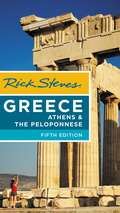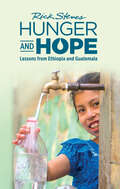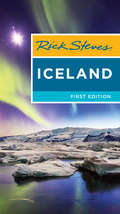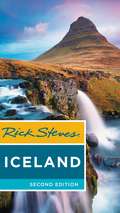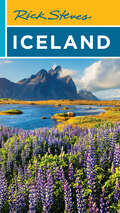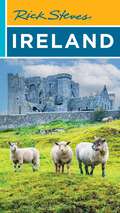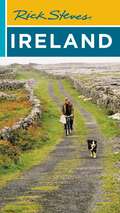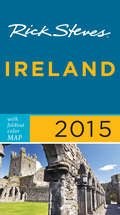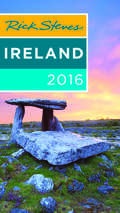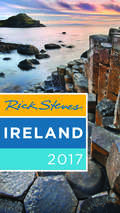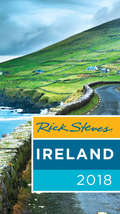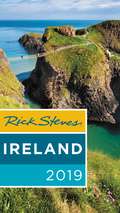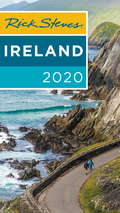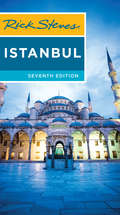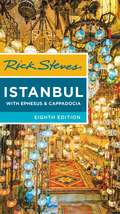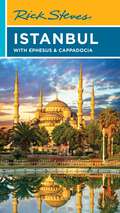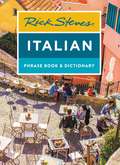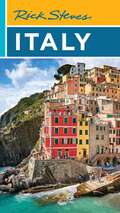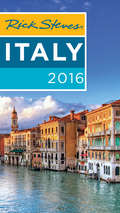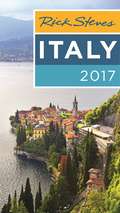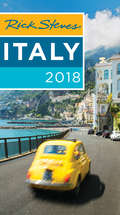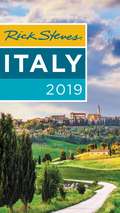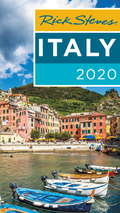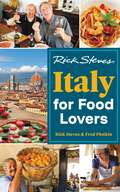- Table View
- List View
Rick Steves Greece: Athens And The Peloponnese (Rick Steves)
by Rick StevesWalk in the steps of Socrates, test the acoustics of the amphitheater of Epidavros, and set sail for Santorini: with Rick Steves on your side, Greece can be yours!Inside Rick Steves Greece: Athens & The Peloponnese you'll find:Comprehensive coverage for spending a week or more exploring GreeceRick's strategic advice on how to get the most out of your time and money, with rankings of his must-see favoritesTop sights and hidden gems, from the Parthenon and the Agora to the small towns and beaches of the Peloponnesian PeninsulaHow to connect with culture: Go back in time at the National Archaeological Museum, sample olives and feta in the Mediterranean sunshine, or sip ouzo at a local tavernaBeat the crowds, skip the lines, and avoid tourist traps with Rick's candid, humorous insightThe best places to eat, sleep, and relax Self-guided walking tours of lively neighborhoods and incredible museums Detailed maps for exploring on the goUseful resources including a packing list, a Greek phrase book, a historical overview, and recommended readingOver 500 bible-thin pages include everything worth seeing without weighing you downComplete, up-to-date information on Athens, Nafplio, Epidavros, Mycenae, Olympia, Patra, Kardamyli, the Mani Peninsula, Sparta, Mystras, Delphi, Hydra, Mykonos, Delos, Santorini, and moreMake the most of every day and every dollar with Rick Steves Greece: Athens & the Peloponnese.Spending a week or less in the city? Check out Rick Steves Pocket Athens!
Rick Steves Hunger and Hope
by Rick StevesIn his one-hour public television special, Rick Steves' Hunger and Hope, travel expert Rick Steves ventures beyond Europe to learn about the key realities of extreme poverty. Inside this companion e-book, you'll uncover Rick's firsthand insights on:How ending world hunger in our lifetime is an attainable goal The importance of water access, education, women's empowerment, and financial literacy in creating long-term independence How communities are using smart development to rise out of povertyJoin Rick Steves in Ethiopia and Guatemala and discover how you can make a difference.
Rick Steves Iceland
by Ian Watson Rick Steves Cameron HewittHike vast glaciers, marvel at steaming volcanic lakes, and explore the land of the midnight sun: with Rick Steves on your side, Iceland can be yours!Inside Rick Steves Iceland you'll find:Comprehensive coverage for exploring Iceland, whether you've got a long layover in Reykjavík or two weeks to dive into the whole countryRick's strategic advice on how to get the most out of your time and money, with rankings of his must-see favoritesTop sights and hidden gems, from the stunning northern lights to hidden hikes and cozy bookstoresHow to connect with local culture: Soak in the famous Blue Lagoon, sample smoked fishes, and chat with locals in stark and lovely rural townsBeat the crowds, skip the lines, and avoid tourist traps with Rick's candid, humorous insightThe best places to eat, sleep, and relax Self-guided walking tours of lively Reykjavík and art and history museumsComplete, mile-by-mile driving tours, including the Golden Circle, the Ring Road, and more, with recommendations of Iceland's most scenic detoursDetailed maps for exploring on the goUseful resources including a packing list, an Icelandic phrase book, a historical overview, and recommended readingOver 500 bible-thin pages include everything worth seeing without weighing you downComplete, up-to-date information on Reykjavík, the Reykjanes Peninsula, the Golden Circle, the South Coast, the Westman Islands, West Iceland, The Ring Road, the East Fjords, and moreMake the most of every day and every dollar with Rick Steves Iceland.Expanding your trip? Try Rick Steves Scandinavia or Rick Steves Northern European Cruise Ports.
Rick Steves Iceland
by Rick StevesHike vast glaciers, marvel at steaming volcanic lakes, and explore the land of the midnight sun: with Rick Steves, Iceland is yours to explore! Inside Rick Steves Iceland you'll find:Comprehensive itineraries that can be adapted for 24-hour layovers, 5-day visits, 2-week trips, and more, including the best road trips in Iceland from the Ring Road to the Golden CircleRick's strategic advice on how to get the most out of your time and money, with rankings of his must-see favoritesTop sights and hidden gems, from the stunning northern lights to hidden hikes and cozy bookstoresHow to connect with local culture: Soak in hidden hot springs, sample smoked fish, and chat with locals in moody and welcoming rural townsBeat the crowds, skip the lines, and avoid tourist traps with Rick's candid, humorous insightThe best places to eat, sleep, and relax Self-guided walking tours of lively Reykjavík and art and history museums and mile-by-mile scenic driving toursDetailed maps for exploring on the goUseful resources including a packing list, an Icelandic phrase book, a historical overview, and recommended readingOver 500 bible-thin pages include everything worth seeing without weighing you downComplete, up-to-date information on Reykjavík, the Reykjanes Peninsula, the Golden Circle, the South Coast, the Westman Islands, West Iceland, The Ring Road, the East Fjords, and moreMake the most of every day and every dollar with Rick Steves Iceland.Expanding your trip? Try Rick Steves Scandinavia or Rick Steves Northern European Cruise Ports.
Rick Steves Iceland (Rick Steves Travel Guide)
by Rick StevesFrom vast glaciers to steaming volcanic lakes, experience the land of the midnight sun with Rick Steves. Inside Rick Steves Iceland you'll find:Comprehensive coverage for spending a week or more exploring Iceland Rick's strategic advice on how to get the most out of your time and money, with rankings of his must-see favorites Top sights and hidden gems, from the stunning northern lights to hidden hikes and cozy bookstores How to connect with culture: Soak in hidden hot springs, sample smoked fish, and chat with locals in welcoming rural towns Beat the crowds, skip the lines, and avoid tourist traps with Rick's candid, humorous insight The best places to eat, sleep, and relaxSelf-guided walking tours of lively Reykjavík and incredible museums as well as mile-by-mile scenic driving toursDetailed maps for exploring on the go Useful resources including a packing list, a historical overview, and helpful Icelandic phrases Over 500 bible-thin pages include everything worth seeing without weighing you down Complete, up-to-date information on Reykjavík, the Ring Road, the Reykjanes Peninsula, the Golden Circle, the South Coast, the Westman Islands, West Iceland, the Eastfjords, and more Make the most of every day and every dollar with Rick Steves Iceland. Expanding your trip? Try Rick Steves Scandinavia or Rick Steves Scandinavian & Northern European Cruise Ports.
Rick Steves Ireland
by Rick Steves Pat O'ConnorFrom rustic towns and emerald valleys to lively cities and moss-draped ruins, the Emerald Isle is yours to discover with Rick Steves! Inside Rick Steves Ireland you'll find:Fully updated, comprehensive coverage for planning a multi-week trip through Ireland Rick's strategic advice on how to get the most of your time and money, with rankings of his must-see favorites Top sights and hidden gems, from the Rock of Cashel and the Ring of Kerry to distilleries making whiskey with hundred-year-old recipes How to connect with local culture: Hoist a pint at the corner pub, enjoy traditional fiddle music, and jump into conversations buzzing with brogue Beat the crowds, skip the lines, and avoid tourist traps with Rick's candid, humorous insight The best places to eat, sleep, and relax with a Guinness Self-guided walking tours of atmospheric neighborhoods and awe-inspiring sights Trip-planning tools, like how to link destinations, build your itinerary, and get from place to place Detailed maps, including a fold-out map for exploring on the go Complete, up-to-date coverage of Dublin, Kilkenny, Waterford, County Wexford, Kinsale, Cobh, Kenmare, The Ring of Kerry, Dingle Peninsula, County Clare, the Burren, Galway, the Aran Islands, Connemara, County Mayo, Belfast, Portrush, the Antrim Coast, Derry, County Donegal, and much more Make the most of every day and every dollar with Rick Steves Ireland. Planning a shorter trip? Check out Rick Steves Best of Ireland.
Rick Steves Ireland (Rick Steves Ser.)
by Rick Steves Patrick O'ConnorNow more than ever, you can count on Rick Steves to tell you what you really need to know when traveling through Ireland. From rustic towns and emerald valleys to lively cities and moss-draped ruins, experience it all with Rick Steves! Inside Rick Steves Ireland you'll find:Fully updated, comprehensive coverage for planning a multi-week trip through IrelandRick's strategic advice on how to get the most of your time and money, with rankings of his must-see favoritesTop sights and hidden gems, from the Rock of Cashel and the Ring of Kerry to distilleries making whiskey with hundred-year-old recipesHow to connect with local culture: Hoist a pint at the corner pub, enjoy traditional fiddle music, and jump into conversations buzzing with brogueBeat the crowds, skip the lines, and avoid tourist traps with Rick's candid, humorous insightThe best places to eat, sleep, and relax with a GuinnessSelf-guided walking tours of atmospheric neighborhoods and awe-inspiring sightsTrip-planning tools, like how to link destinations, build your itinerary, and get from place to placeDetailed maps, including a fold-out map for exploring on the goCoverage of Dublin, Kilkenny, Waterford, County Wexford, Kinsale, Cobh, Kenmare, The Ring of Kerry, Dingle Peninsula, County Clare, the Burren, Galway, the Aran Islands, Connemara, County Mayo, Belfast, Portrush, the Antrim Coast, Derry, County Donegal, and much moreCovid-related travel info and resources for a smooth tripMake the most of every day and every dollar with Rick Steves Ireland.Planning a one- to two-week trip? Check out Rick Steves Best of Ireland.
Rick Steves Ireland (Rick Steves' Ser.)
by Rick Steves Pat O'ConnorFrom rustic towns and emerald valleys to lively cities and moss-draped ruins, experience Ireland with Rick Steves! Inside Rick Steves Ireland you'll find:Comprehensive coverage for planning a multi-week trip through IrelandRick's strategic advice on how to get the most of your time and money, with rankings of his must-see favoritesTop sights and hidden gems, from the Rock of Cashel and the Ring of Kerry to distilleries making whiskey with hundred-year-old recipesHow to connect with local culture: Hoist a pint at the corner pub, enjoy traditional fiddle music, and jump into conversations buzzing with brogueBeat the crowds, skip the lines, and avoid tourist traps with Rick's candid, humorous insightThe best places to eat, sleep, and relax with a GuinnessSelf-guided walking tours of atmospheric neighborhoods and awe-inspiring sightsTrip-planning tools, like how to link destinations, build your itinerary, and get from place to placeDetailed maps, including a fold-out map for exploring on the goUseful resources including a packing list, Irish phrase book, historical overview, and recommended readingOver 1,000 bible-thin pages include everything worth seeing without weighing you downCoverage of Dublin, Kilkenny, Waterford, County Wexford, Kinsale, Cobh, Kenmare, The Ring of Kerry, Dingle Peninsula, County Clare, the Burren, Galway, the Aran Islands, Connemara, County Mayo, Belfast, Portrush, the Antrim Coast, Derry, County Donegal, and much moreMake the most of every day and every dollar with Rick Steves Ireland.Planning a one- to two-week trip? Check out Rick Steves Best of Ireland.
Rick Steves Ireland 2015
by Rick Steves Pat O'ConnorYou can count on Rick Steves to tell you what you really need to know when traveling in Ireland.With this guide, you can explore lively Dublin, quaint Kilkenny, and the moss-draped ruins of the Ring of Kerry. Navigate meandering back roads that lead to windswept crags on the dramatic Dingle Peninsula. Explore Ireland's revered past by following St. Patrick's footsteps to the Rock of Cashel. Marvel at Newgrange, the mysterious mound older than the pyramids; then connect with today's Irish culture by grabbing a pint at the local pub, enjoying the fiddle music, and jumping into conversations that buzz with brogue.Rick's candid, humorous advice will guide you to good-value hotels and restaurants. He'll help you plan where to go and what to see, depending on the length of your trip. You'll get up-to-date recommendations on what is worth your time and money. More than just reviews and directions, a Rick Steves guidebook is a tour guide in your pocket.
Rick Steves Ireland 2016
by Rick Steves Pat O'ConnorYou can count on Rick Steves to tell you what you really need to know when traveling in Ireland. With this guide, you can explore lively Dublin, quaint Kilkenny, and the moss-draped ruins of the Ring of Kerry. Navigate meandering back roads that lead to windswept crags on the dramatic Dingle Peninsula. Explore Ireland’s revered past by following St. Patrick’s footsteps to the Rock of Cashel. Marvel at Newgrange, the mysterious mound older than the pyramids; then connect with today’s Irish culture by grabbing a pint at the local pub, enjoying the fiddle music, and jumping into conversations that buzz with brogue. Rick’s candid, humorous advice will guide you to good-value hotels and restaurants. He’ll help you plan where to go and what to see, depending on the length of your trip. You’ll get up-to-date recommendations on what is worth your time and money. More than just reviews and directions, a Rick Steves guidebook is a tour guide in your pocket.
Rick Steves Ireland 2017
by Rick Steves Pat O’connorYou can count on Rick Steves to tell you what youreally need to know when traveling in Ireland. With this guide, you can explore lively Dublin, quaint Kilkenny, and the moss-draped ruins of the Ring of Kerry. Navigate meandering back roads that lead to windswept crags on the dramatic Dingle Peninsula. Explore Ireland’s revered past by following St. Patrick’s footsteps to the Rock of Cashel. Marvel at Newgrange, the mysterious mound older than the pyramids; then connect with today’s Irish culture by grabbing a pint at the local pub, enjoying the fiddle music, and jumping into conversations that buzz with brogue. Rick’s candid, humorous advice will guide you to good-value hotels and restaurants. He’ll help you plan where to go and what to see, depending on the length of your trip. You’ll get up-to-date recommendations on what is worth your time and money. More than just reviews and directions, a Rick Steves guidebook is a tour guide in your pocket.
Rick Steves Ireland 2018 (Rick Steves)
by Rick Steves Pat O'ConnorWander rustic towns, emerald valleys, lively cities, and moss-draped ruins: with Rick Steves on your side, Ireland can be yours!Inside Rick Steves Ireland 2018 you'll find:Comprehensive coverage for planning a multi-week trip through Ireland with deep dives into each regionRick's strategic advice on how to get the most of your time and money, with rankings of his must-see favoritesTop sights and hidden gems, from the Rock of Cashel and the Ring of Kerry to distilleries making whiskey with hundred-year old recipesHow to connect with local culture: Hoist a pint at the corner pub, enjoy traditional fiddle music, and jump into conversations buzzing with brogueBeat the crowds, skip the lines, and avoid tourist traps with Rick's candid, humorous insightThe best places to eat, sleep, and relax over a GuinnessSelf-guided walking tours of lively neighborhoods and awe-inspiring museumsVital trip-planning tools, like how to link destinations, build your itinerary, and get from place to place Detailed maps, including a fold-out map for exploring on the goUseful resources including a packing list, Irish phrasebook, a historical overview, and recommended readingOver 1,000 bible-thin pages include everything worth seeing without weighing you downAnnually updated information on Dublin, Kilkenny, Waterford, County Wexford, Kinsale, Cobh, Kenmare, The Ring of Kerry, Dingle Peninsula, County Clare, the Burren, Galway, the Aran Islands, Connemara, County Mayo, Belfast, Portrush, the Antrim Coast, Derry, County Donegal, and much moreMake the most of every day and every dollar with Rick Steves Ireland 2018.Planning a one- to two-week trip? Check out Rick Steves Best of Ireland.
Rick Steves Ireland 2019 (Rick Steves)
by Rick Steves Pat O'ConnorWander rustic towns, emerald valleys, lively cities, and moss-draped ruins: with Rick Steves on your side, Ireland can be yours! Inside Rick Steves Ireland 2019 you'll find:Comprehensive coverage for planning a multi-week trip through IrelandRick's strategic advice on how to get the most of your time and money, with rankings of his must-see favoritesTop sights and hidden gems, from the Rock of Cashel and the Ring of Kerry to distilleries making whiskey with hundred-year-old recipesHow to connect with local culture: Hoist a pint at the corner pub, enjoy traditional fiddle music, and jump into conversations buzzing with brogueBeat the crowds, skip the lines, and avoid tourist traps with Rick's candid, humorous insightThe best places to eat, sleep, and relax with a GuinnessSelf-guided walking tours of lively neighborhoods and awe-inspiring sightsTrip-planning tools, like how to link destinations, build your itinerary, and get from place to placeDetailed maps, including a fold-out map for exploring on the goUseful resources including a packing list, Irish phrase book, historical overview, and recommended readingOver 1,000 bible-thin pages include everything worth seeing without weighing you downAnnually updated information on Dublin, Kilkenny, Waterford, County Wexford, Kinsale, Cobh, Kenmare, The Ring of Kerry, Dingle Peninsula, County Clare, the Burren, Galway, the Aran Islands, Connemara, County Mayo, Belfast, Portrush, the Antrim Coast, Derry, County Donegal, and much moreMake the most of every day and every dollar with Rick Steves Ireland 2019.Planning a one- to two-week trip? Check out Rick Steves Best of Ireland.
Rick Steves Ireland 2020 (Rick Steves Travel Guide)
by Rick Steves Pat O'ConnorWander rustic towns, emerald valleys, lively cities, and moss-draped ruins: Experience Ireland with Rick Steves by your side. Inside Rick Steves Ireland 2020 you'll find:Comprehensive coverage for planning a multi-week trip through IrelandRick's strategic advice on how to get the most of your time and money, with rankings of his must-see favoritesTop sights and hidden gems, from the Rock of Cashel and the Ring of Kerry to distilleries making whiskey with hundred-year-old recipesHow to connect with local culture: Hoist a pint at the corner pub, enjoy traditional fiddle music, and jump into conversations buzzing with brogueBeat the crowds, skip the lines, and avoid tourist traps with Rick's candid, humorous insightThe best places to eat, sleep, and relax with a GuinnessSelf-guided walking tours of atmospheric neighborhoods and awe-inspiring sightsTrip-planning tools, like how to link destinations, build your itinerary, and get from place to placeDetailed maps, including a fold-out map for exploring on the goUseful resources including a packing list, Irish phrase book, historical overview, and recommended readingOver 1,000 bible-thin pages include everything worth seeing without weighing you downAnnually updated information on Dublin, Kilkenny, Waterford, County Wexford, Kinsale, Cobh, Kenmare, The Ring of Kerry, Dingle Peninsula, County Clare, the Burren, Galway, the Aran Islands, Connemara, County Mayo, Belfast, Portrush, the Antrim Coast, Derry, County Donegal, and much moreMake the most of every day and every dollar with Rick Steves Ireland 2020.Planning a one- to two-week trip? Check out Rick Steves Best of Ireland.
Rick Steves Istanbul
by Lale Surmen Aran Tankut AranYou can count on Rick Steves to tell you what you really need to know when traveling in Istanbul.Following Rick's self-guided tours, you'll experience the wonders of East and West in this fascinating city-the capital of two great empires. Explore one of the world's largest domed churches, haggle with merchants in the exotic Grand Bazaar, and discover the secrets of the sultan's harem in Topkapi Palace. Wander through monumental mosques, shop along sophisticated avenues, and watch whirling dervishes in action. Cruise the Bosphorus for a quick trip to Asia, and end the day relaxing in a Turkish bath.Rick's candid, humorous advice will guide you to good-value hotels and restaurants in delightful neighborhoods. You'll learn how to get around on the city's trams and ferries, and which sights are worth your time and money. More than just reviews and directions, a Rick Steves guidebook is a tour guide in your pocket.
Rick Steves Istanbul: With Ephesus & Cappadocia (Rick Steves)
by Lale Surmen Aran Tankut AranWalk in the footsteps of emperors and sultans, marvel at some of the greatest monuments on earth, and experience the wonders of East and West with Rick Steves! Inside Rick Steves Istanbul you'll find:Comprehensive coverage for spending a week or more exploring IstanbulTop sights and hidden gems, from the world's largest domed churches and monumental mosques to relaxing Turkish bathsHow to connect with local culture: Haggle with merchants in the lively Grand Bazaar, shop along sophisticated avenues, and watch whirling dervishes in actionBeat the crowds, skip the lines, and avoid tourist traps The best places to eat, sleep, and relax Self-guided walking tours of lively neighborhoods and incredible museumsDetailed neighborhood maps for exploring on the goStrategic advice from trusted Rick Steves Europe tour guides Lale and Tankut Aran on how to get the most out of your time and money, with rankings of their must-see favoritesUseful resources including a packing list, a Turkish phrase book, a historical overview, and recommended readingUpdated to reflect changes that occurred during the Covid-19 pandemic up to the date of publicationOver 400 bible-thin pages include everything worth seeing without weighing you downComplete, up-to-date information on Istanbul's neighborhoods, plus a cruise along the Bosphorus StraitMake the most of every day and every dollar with Rick Steves Istanbul.
Rick Steves Istanbul: With Ephesus & Cappadocia (Rick Steves)
by Rick Steves Lale Surmen Aran Tankut AranWalk in the footsteps of emperors and sultans, marvel at some of the greatest monuments on earth, and experience the wonders of East and West with Rick Steves! Inside Rick Steves Istanbul you'll find:Comprehensive coverage for exploring Istanbul Top sights and hidden gems, from the world's largest domed churches and monumental mosques to relaxing Turkish baths How to connect with local culture: Haggle with merchants in the lively Grand Bazaar, shop along sophisticated avenues, and watch whirling dervishes in action Beat the crowds, skip the lines, and avoid tourist traps The best places to eat, sleep, and relax Self-guided walking tours of lively neighborhoods and incredible museums Detailed neighborhood maps for exploring on the go Strategic advice from trusted Rick Steves Europe tour guides Lale and Tankut Aran on how to get the most out of your time and money, with rankings of their must-see favorites Useful resources including a packing list, a Turkish phrase book, a historical overview, and recommended reading Over 400 bible-thin pages include everything worth seeing without weighing you down Complete, up-to-date information on Istanbul's neighborhoods, plus a cruise along the Bosphorus Strait Make the most of every day and every dollar with Rick Steves Istanbul.
Rick Steves Italian Phrase Book & Dictionary (Rick Steves Travel Guide)
by Rick StevesBuon giorno! From ordering calamari in Venice to making new friends in Tuscan hill towns, it helps to speak some of the native tongue in Italy. Rick Steves offers well-tested Italian words and phrases that come in handy in a variety of situations. Inside you'll find:Key phrases for use in everyday circumstances, complete with phonetic spellingAn English-Italian and Italian-English dictionaryTips for small talk and local lingo with Rick's signature sense of humor A tear-out cheat sheet for continued language practice as you wait in line at the Sistine Chapel (no internet connection required!)Informative, concise, and practical, Rick Steves Italian Phrase Book is an essential item for any traveler's pocket.
Rick Steves Italy (Rick Steves Travel Guide)
by Rick StevesFrom the Mediterranean to the Alps, from fine art to fresh pasta, experience it all with Rick Steves! Inside Rick Steves Italy you'll find:Fully updated, comprehensive coverage for planning a multi-week trip to Italy Rick's strategic advice on how to get the most out of your time and money, with rankings of his must-see favorites Top sights and hidden gems, from the Colosseum and Michelangelo's David to corner trattorias and that perfect scoop of gelato How to connect with local culture: Walk in Caesar's footsteps through the ruins of the Forum, discover the relaxed rhythms of sunny Cinque Terre, or chat with fans about the latest soccer match (calcio, to locals) Beat the crowds, skip the lines, and avoid tourist traps with Rick's candid, humorous insight The best places to eat, sleep, and experience la dolce vitaSelf-guided walking tours of lively neighborhoods and museums Vital trip-planning tools, like how to link destinations, build your itinerary, and get from place to place Detailed maps, including a fold-out map for exploring on the go Over 1,000 bible-thin pages include everything worth seeing without weighing you down Coverage of Venice, the Dolomites, Lake Country, Milan, the Cinque Terre, the Italian Riviera, Florence, Pisa, Lucca, Siena, Tuscany, Rome, Naples, Pompeii, Sorrento, the Amalfi Coast, and much more Make the most of every day and every dollar with Rick Steves Italy. Planning a one- to two-week trip? Check out Rick Steves Best of Italy.
Rick Steves Italy 2015
by Rick StevesYou can count on Rick Steves to tell you what you really need to know when traveling in Italy.From the beaches to the Alps, from fine art to fine pasta, Italy has it all. With this book, you'll trace Italian culture from Rome's Colosseum to Michelangelo's David to the bustling elegance of Milan. Experience the art-drenched cities of Venice and Florence, explore the ancient ruins of the Roman Forum, and learn how to avoid the lines at the most popular museums. Discover the villages of Tuscany and Umbria and the lazy rhythms of the Cinque Terre. Shop at local market stalls, sip a cappuccino at an outdoor café, and pick up a picnic lunch at an allimentari. Relax and enjoy the life of Bella Italia!Rick's candid, humorous advice will guide you to good-value hotels and restaurants. He'll help you plan where to go and what to see, depending on the length of your trip. You'll get up-to-date recommendations about what is worth your time and money. More than just reviews and directions, a Rick Steves guidebook is a tour guide in your pocket.
Rick Steves Italy 2017
by Rick StevesYou can count on Rick Steves to tell you what you really need to know when traveling in Italy.From the beaches to the Alps, from fine art to fine pasta, Italy has it all. With this book, you'll trace Italian culture from Rome's Colosseum to Michelangelo's David to the bustling elegance of Milan. Experience the art-drenched cities of Venice and Florence, explore the ancient ruins of the Roman Forum, and learn how to avoid the lines at the most popular museums. Discover the villages of Tuscany and Umbria and the lazy rhythms of the Cinque Terre. Shop at local market stalls, sip a cappuccino at an outdoor café, and pick up a picnic lunch at an allimentari. Relax and enjoy the life of Bella Italia!Rick's candid, humorous advice will guide you to good-value hotels and restaurants. He'll help you plan where to go and what to see, depending on the length of your trip. You'll get up-to-date recommendations about what is worth your time and money. More than just reviews and directions, a Rick Steves guidebook is a tour guide in your pocket.
Rick Steves Italy 2018 (Rick Steves)
by Rick StevesYou can count on Rick Steves to tell you what you really need to know when traveling in Italy.From the beaches to the Alps, from fine art to fine pasta, Italy has it all. With this book, you'll trace Italian culture from Rome's Colosseum to Michelangelo's David to the bustling elegance of Milan. Experience the art-drenched cities of Venice and Florence, explore the ancient ruins of the Roman Forum, and learn how to avoid the lines at the most popular museums. Discover the villages of Tuscany and Umbria and the lazy rhythms of the Cinque Terre. Shop at local market stalls, sip a cappuccino at an outdoor café, and pick up a picnic lunch at an allimentari. Relax and enjoy the life of Bella Italia!Rick's candid, humorous advice will guide you to good-value hotels and restaurants. He'll help you plan where to go and what to see, depending on the length of your trip. You'll get up-to-date recommendations about what is worth your time and money. More than just reviews and directions, a Rick Steves guidebook is a tour guide in your pocket.
Rick Steves Italy 2019 (Rick Steves)
by Rick StevesFrom the Mediterranean to the Alps, from fine art to fine pasta: with Rick Steves on your side, Italy can be yours!Inside Rick Steves Italy 2019 you'll find:Comprehensive coverage for planning a multi-week trip to ItalyRick's strategic advice on how to get the most out of your time and money, with rankings of his must-see favoritesTop sights and hidden gems, from the Colosseum and Michelangelo's David to corner trattorias and that perfect scoop of gelatoHow to connect with local culture: Browse weekend open-air markets, discover the relaxed rhythms of sunny Cinque Terre, or chat with fans about the latest soccer match (calcio, to locals) Beat the crowds, skip the lines, and avoid tourist traps with Rick's candid, humorous insightThe best places to eat, sleep, and experience la dolce far nienteSelf-guided walking tours of lively neighborhoods and incredible museumsVital trip-planning tools, like how to link destinations, build your itinerary, and get from place to place Detailed maps, including a fold-out map for exploring on the goUseful resources including a packing list, Italian phrase book, a historical overview, and recommended readingOver 1,000 bible-thin pages include everything worth seeing without weighing you downAnnually updated information on Venice, Padua, The Dolomites, Lake Country, Milan, Italian Riviera, Florence, Pisa, Lucca, Hill Towns of Central Italy, Siena, Tuscany, Rome, Naples, Pompeii, Capri, the Amalfi Coast, and much moreMake the most of every day and every dollar with Rick Steves Italy 2019.Planning a one- to two-week trip? Check out Rick Steves Best of Italy.Special ebook features:Easily navigate listings with quick searches, plus website links and zoom-in maps and imagesPersonalize your guide by adding notes and bookmarks
Rick Steves Italy 2020 (Rick Steves Travel Guide)
by Rick StevesFrom the Mediterranean to the Alps, from fine art to fine pasta, experience Italy with Rick Steves! Inside Rick Steves Italy 2020 you'll find:Comprehensive coverage for planning a multi-week trip to ItalyRick's strategic advice on how to get the most out of your time and money, with rankings of his must-see favoritesTop sights and hidden gems, from the Colosseum and Michelangelo's David to corner trattorias and that perfect scoop of gelatoHow to connect with local culture: Walk in Caesar's footsteps through the ruins of the Forum, discover the relaxed rhythms of sunny Cinque Terre, or chat with fans about the latest soccer match (calcio, to locals) Beat the crowds, skip the lines, and avoid tourist traps with Rick's candid, humorous insightThe best places to eat, sleep, and experience la dolce far nienteSelf-guided walking tours of lively neighborhoods and museumsVital trip-planning tools, like how to link destinations, build your itinerary, and get from place to place Detailed maps, including a fold-out map for exploring on the goUseful resources including a packing list, Italian phrase book, a historical overview, and recommended readingOver 1,000 bible-thin pages include everything worth seeing without weighing you downAnnually updated information on Venice, Padua, the Dolomites, Lake Country, Milan, the Italian Riviera, Florence, Pisa, Lucca, Hill Towns of Central Italy, Siena, Tuscany, Rome, Naples, Pompeii, Capri, the Amalfi Coast, and much moreMake the most of every day and every dollar with Rick Steves Italy 2020.Planning a one- to two-week trip? Check out Rick Steves Best of Italy.
Rick Steves Italy for Food Lovers
by Rick Steves Fred PlotkinSip, savor, and get the most out of every bite with Rick Steves! With this fun and practical guide to eating well in Italy, you&’ll:Indulge in the best of Italy&’s cuisine, from tantalizing antipasti and saucy pastas to luxurious gelato Get a taste of the coffee culture and vibrant wine scene Discover what to eat where with food and wine specialties from the country&’s 20 regions Find lists of Rick's favorite restaurants in every region Follow Rick&’s tips to find restaurants for any budget, smartly navigate the menu, and decipher the check Hurdle the language barrier with the ultimate Italian food glossary Enjoy full-color, inspiring photos throughoutCommemorate your culinary adventures with a foldout souvenir poster mapRick Steves and co-author Fred Plotkin have devoted decades to traveling through Italy. In this book, they pass along those lessons to you. Appreciate good food the way Italians do with Rick Steves Italy for Food Lovers.
